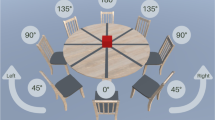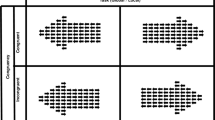Abstract
Mentalizing refers to making inferences about other people’s mental states, whereas visuospatial perspective taking refers to inferring other people’s viewpoints. Both abilities seem vital for social functioning; yet, their exact relationship is unclear. We directly compared mentalizing and visuospatial perspective taking in nineteen adults with Asperger syndrome (AS) and fifteen control participants with the same stimulus material. Stimuli depicted virtual characters surrounded by two different objects. Virtual characters expressed a preference for one of the objects indicated by facial expression, gestures or head/body orientation. Compared to controls, participants with AS showed significantly increased reaction times and decreased accuracy for mentalizing (i.e., when inferring the virtual character’s preference from the character’s nonverbal bodily cues). By contrast, there were no significant group differences in perspective taking (i.e., by mental own-body transformations). These findings demonstrate, first, specific deficits in AS when mental states have to be inferred from nonverbal social cues. Second, visuospatial perspective taking may not necessarily be related to social impairments occurring in autism spectrum disorders.



Similar content being viewed by others
Notes
EHI is missing in five control participants.
References
Aichhorn, M., Perner, J., Kronbichler, M., Staffen, W., & Ladurner, G. (2006). Do visual perspective tasks need theory of mind? NeuroImage, 30, 1059–1068.
Attwood, A., Frith, U., & Hermelin, B. (1988). The understanding and use of interpersonal gestures by autistic and Down’s syndrome children. Journal of Autism and Developmental Disorders, 18, 241–257.
Baron-Cohen, S. (1988). Social and pragmatic deficits in autism: Cognitive or affective? Journal of Autism and Developmental Disorders, 18, 379–402.
Baron-Cohen, S. (1997). Mindblindness—An essay on autism and theory of mind. MIT Press: Cambridge.
Baron-Cohen, S., Jolliffe, T., Mortimore, C., & Robertson, M. (1997). Another advanced test of theory of mind: Evidence from very high functioning adults with autism or Asperger Syndrome. Journal of Child Psychology and Psychiatry, 38, 813–822.
Baron-Cohen, S., Leslie, A. M., & Frith, U. (1985). Does the autistic child have a “theory of mind”? Cognition, 21, 37–46.
Baron-Cohen, S., Wheelwright, S., & Hill, J. (2001a). The ‘Reading the mind in the eyes’ test revised version: A study with normal adults, and adults with Asperger syndrome or high-functioning autism. Journal of Child Psychology and Psychiatry, 42, 241–252.
Baron-Cohen, S., Wheelwright, S., Skinner, R., Martin, J., & Clubley, E. (2001b). The Autism Spectrum Quotient (AQ): Evidence from Asperger syndrome/high functioning autism, males and females, scientists and mathematicians. Journal of Autism and Developmental Disorders, 31, 5–17.
Bente, G., Krämer, N. C., Petersen, A., & de Ruiter, J. P. (2001). Computer animated movement and person perception: Methodological advances in nonverbal behavior research. Journal of Nonverbal Behavior, 25, 151–166.
Bewernick, B. H., David, N., & Vogeley, K. (2005). Certainty of mental attribution in a nonverbal theory of mind task. Journal of Cognitive Neuroscience, Suppl., 69–70.
Blanke, O., Mohr, C., Michel, C. M., Pascual-Leone, A., Brugger, P., Seeck, M., et al. (2005). Linking out-of-body experience and self processing to mental own-body imagery at the temporoparietal junction. Journal of Neuroscience, 25, 550–557.
Bowler, D. M. (1992). Theory of mind in asperger’s syndrome. Journal of Child Psychology, 33, 877–893.
Carruthers, P. (2009). How we know our own minds: The relationship between mindreading and metacognition. Behavioral and Brain Sciences, 32, 121–138.
Cherkassky, V. L., Kana, R. K., Keller, T. A., & Just, M. A. (2006). Functional connectivity in a baseline resting-state network in autism. NeuroReport, 17, 1687–1690.
Cohen, M. X., David, N., Vogeley, K., & Elger, C. E. (2009). Gamma-band activity in the human superior temporal sulcus during mentalizing from nonverbal social cues. Psychophysiology, 46, 43–51.
David, N., Aumann, C., Santos, N. S., Bewernick, B. H., Eickhoff, S. B., Newen, A., et al. (2008). Differential involvement of posterior temporal cortex in mentalizing not perspective taking. Social Cognitive and Affective Neuroscience, 3, 279–289.
Flavell, J. H., Green, F. L., & Flavell, E. R. (1986). Development of knowledge about the appearance-reality distinction. Monographs of the Society for Research in Child Development, 51, 1–68.
Flavell, J. H., Shipstead, S. G., & Croft, K. (1978). Young children’s knowledge about visual perception: Hiding objects from others. Child Development, 49, 1208–1211.
Frith, U. (1996). Social communication and its disorder in autism and Asperger syndrome. Journal of Psychopharmacology, 10, 48–53.
Frith, U., & de Vignemont, F. (2005). Egocentrism, allocentrism, and Asperger syndrome. Consciousness and Cognition, 14, 719–738.
Frith, U., & Frith, C. D. (1999). Interacting minds—A biological basis. Science, 286, 1692–1695.
Frith, C. D., & Frith, U. (2006). The neural basis of mentalizing. Neuron, 50, 531–534.
Frith, C. D., & Frith, U. (2008). The self and its reputation in autism. Neuron, 57, 331–332.
Gallagher, H. L., & Frith, C. D. (2004). Dissociable neural pathways for the perception and recognition of expressive and instrumental gestures. Neuropsychologia, 42(13), 1725–1736.
Gallese, V., & Goldman, A. (1998). Mirror neurons and the simulation theory of mind-reading. Trends in Cognitive Sciences, 4, 252–254.
Gusnard, D. A., Akbudak, E., Shulman, G. L., & Raichle, M. E. (2001). Medial prefrontal cortex and self-referential mental activity: Relation to a default mode of brain function. Proceedings of the National Academy of Sciences USA, 98, 4259–4264.
Happé, F. G. (1994). An advanced test of theory of mind: Understanding of story characters’ thoughts and feelings by able autistic, mentally handicapped, and normal children and adults. Journal of Autism and Developmental Disorders, 24, 129–154.
Happé, F., Ehlers, S., Fletcher, P., Frith, U., Johansson, M., Gillberg, C., et al. (1996). ‘‘Theory of mind’’ in the brain. Evidence from a PET scan study of Asperger syndrome. Neuroreport, 8, 197–201.
Hare, B., Call, J., & Tomasello, M. (2001). Do chimpanzees know what conspecifics know? Animal Behavior, 61, 139–151.
Heavey, L., Phillips, W., Baron-Cohen, S., & Rutter, M. (2000). The awkward moments test: A naturalistic measure of social understanding in autism. Journal of Autism and Developmental Disorders, 30, 225–236.
Hobson, R. P. (1984). Early childhood autism and the question of egocentrism. Journal of Autism and Developmental Disorder, 14, 85–104.
Horn, W. (1983). Leistungsprüfsystem (LPS). In Handanweisung. Hogrefe: Göttingen.
Kaiser, S., Walther, S., Nennig, E., Kronmuller, K., Mundt, C., Weisbrod, M., et al. (2008). Gender-specific strategy use and neural correlates in a spatial perspective taking task. Neuropsychologia, 46, 2524–2531.
Kennedy, D. P., Redcay, E., & Courchesne, E. (2006). Failing to deactivate: Resting functional abnormalities in autism. Proceedings of the National Academy of Sciences USA, 103, 8275–8280.
Knickmeyer, R. C., & Baron-Cohen, S. (2006). Fetal testosterone and sex differences in typical social development and in autism. Journal of Child Neurology, 21, 825–845.
Langdon, R., & Coltheart, M. (2001). Visual perspective-taking and schizotypy: Evidence for a simulation-based account of mentalizing in normal adults. Cognition, 82, 1–26.
Lee, A., & Hobson, R. P. (1998). On developing self-concepts: A controlled study of children and adolescents with autism. Journal of Child Psychology and Psychiatry, 39, 1131–1144.
Leslie, A. M., & Frith, U. (1988). Autistic children’s understanding of seeing, knowing, and believing. British Journal of Developmental Psychology, 6, 315–324.
Lombardo, M. V., Barnes, J. L., Wheelwright, S. J., & Baron-Cohen, S. (2007). Self-referential cognition and empathy in autism. PLoS ONE, 2, e883.
Mason, M. F., & Macrae, C. N. (2008). Perspective-taking from a social neuroscience standpoint. Group Processes & Intergroup Relations, 11, 215–232.
Newcombe, N. (1989). The development of spatial perspective taking. Advances in Child Development and Behavior, 22, 203–247.
Oldfield, R. C. (1971). The assessment and analysis of handedness: The Edinburgh inventory. Neuropsychologia, 9, 97–113.
Parsons, L. M. (1987). Imagined transformation of one’s body. Journal of Experimental Psychology: General, 116, 172–191.
Parsons, T. D., Larson, P., Kratz, K., Thiebaux, M., Bluestein, B., Buckwalter, J. G., et al. (2004). Sex differences in mental rotation and spatial rotation in a virtual environment. Neuropsychologia, 42, 555–562.
Perner, J. (1993). Understanding the representational mind. MIT press: Cambridge.
Perner, J., Frith, U., Leslie, A. M., & Leekam, S. R. (1989). Exploration of the autistic child’s theory of mind: Knowledge, belief, and communication. Child Development, 60, 688–700.
Piaget, J. & Inhelder, B. (Eds.). (1967). The coordination of perspectives. In The child’s conception of space (pp. 209–246). New York: Norton & Co.
Povinelli, D. J., & Eddy, T. J. (1996). What young chimpanzees know about seeing. Monographs of the Society for Research in Child Development, 61, i–vi, 1–152; discussion 153–191.
Premack, D., & Woodruff, G. (1978). Does the chimpanzee have a theory of mind? Behavioural and Brain Sciences, 4, 515–526.
Reed, C. L., Beall, P. M., Stone, V. E., Kopelioff, L., Pulham, D. J., & Hepburn, S. L. (2007). Brief report: Perception of body posture—What individuals with autism spectrum disorder might be missing. Journal of Autism and Developmental Disorders, 37, 1576–1584.
Reed, T., & Peterson, C. (1990). A comparative study of autistic subjects’ performance at two levels of visual and cognitive perspective taking. Journal of Autism and Developmental Disorders, 20, 555–567.
Rochat, P. (1995). Perceived reachability for self and for others by three- to five-year-old children and adults. Journal of Experimental Child Psychology, 59, 317–333.
Schilbach, L., Eickhoff, S. B., Rotarska-Jagiela, A., Fink, G. R., & Vogeley, K. (2008). Minds at rest? Social cognition as the default mode of cognizing and its putative relationship to the “default system” of the brain. Consciousness and Cognition, 17, 457–467.
Tan, J., & Harris, P. J. (1991). Autistic children understand seeing and wanting. Development and Psychopathology, 3, 163–174.
Tewes, U. (1991). Hamburg-Wechsler Intelligenztest fuer Erwachsene. In Revision 1991. Huber: Bern.
Vogeley, K., Bussfeld, P., Newen, A., Herrmann, S., Happe, F., Falkai, P., et al. (2001). Mind reading: Neural mechanisms of theory of mind and self-perspective. NeuroImage, 14, 170–181.
Vogeley, K., & Fink, G. R. (2003). Neural correlates of the first-person-perspective. Trends in Cognitive Sciences, 7, 38–42.
Wellman, H. M., & Woolley, J. D. (1990). From simple desires to ordinary beliefs: The early development of everyday psychology. Cognition, 35(3), 245–275.
Williams, D., Happe, F., & Jarrold, C. (2008). Intact inner speech use in autism spectrum disorder: Evidence from a short-term memory task. Journal of Child Psychology and Psychiatry, 49, 51–58.
Wimmer, H., & Perner, J. (1983). Beliefs about beliefs: Representation and constraining function of wrong beliefs in young children’s understanding of deception. Cognition, 13, 103–128.
Yirmiya, N., Sigman, M., & Zacks, D. (1994). Perceptual perspective-taking and seriation abilities in high-functioning children with autism. Development and Psychopathology, 6, 263–272.
Zacks, J., Rypma, B., Gabrieli, J. D., Tversky, B., & Glover, G. H. (1999). Imagined transformations of bodies: An fMRI investigation. Neuropsychologia, 37, 1029–1040.
Acknowledgments
We thank Astrid Gawronski, Alexandra Georgescu and Silvia Linnartz for help with neuropsychological assessment. Oliver Döhrmann and Elisa May Matos are gratefully acknowledged for help with stimulus generation, and Andrew Sharott for comments on the manuscript. The project was supported by the German Volkswagen Foundation (N.D., N.S., K.V.) and by the German Ministry of Research and Education (K.V.).
Author information
Authors and Affiliations
Corresponding author
Rights and permissions
About this article
Cite this article
David, N., Aumann, C., Bewernick, B.H. et al. Investigation of Mentalizing and Visuospatial Perspective Taking for Self and Other in Asperger Syndrome. J Autism Dev Disord 40, 290–299 (2010). https://doi.org/10.1007/s10803-009-0867-4
Received:
Accepted:
Published:
Issue Date:
DOI: https://doi.org/10.1007/s10803-009-0867-4




